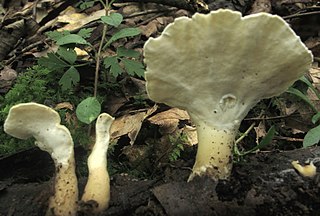Abundisporus is a small genus of poroid fungi currently with seven recognized species. They differ from other polypores in having coloured rather than hyaline spores.

The Meruliaceae are a family of fungi in the order Polyporales. According to a 2008 estimate, the family contains 47 genera and 420 species. As of April 2018, Index Fungorum accepts 645 species in the family.

The Phanerochaetaceae are a family of mostly crust fungi in the order Polyporales.

The Sparassidaceae are a family of fungi in the order Polyporales. The family was circumscribed by German botanist Wilhelm Herter in 1910 to contain the genus Sparassis. Sparassiella was added to the family in 1964. As of April 2018, Index Fungorum accepts 10 species in the Sparassidaceae.

The Steccherinaceae are a family of about 200 species of fungi in the order Polyporales. It includes crust-like, toothed, and poroid species that cause a white rot in dead wood.

Auriporia is a small genus of four species of poroid fungi in the family Fomitopsidaceae.

Haploporus is a genus of poroid fungi in the family Polyporaceae.

Meruliopsis is a genus of poroid crust fungi. The genus was circumscribed by Russian mycologist Appollinaris Semenovich Bondartsev in 1959.
Gelatoporia is a fungal genus in the family Gelatoporiaceae. This is a monotypic genus, containing the single widely distributed species Gelatoporia subvermispora. The genus was circumscribed in 1985 by Finnish mycologist Tuomo Niemelä to contain poroid crust fungi with a monomitic hyphal structure, clamped hyphae, and producing white rot.

Irpex is a genus of corticioid fungi in the order Polyporales. Species produce fruit bodies that grow as a crust on the surface of dead hardwoods. The crust features an irpicioid spore-bearing surface, meaning it has irregular and flattened teeth. Irpex is distinguished from the similar genera Junghuhnia and Steccherinum by the simple septa found in the generative hyphae.

Loweomyces is a genus of six species of poroid fungi in the family Steccherinaceae.

Mycorrhaphium is a genus of fungi in the family Steccherinaceae. The genus was circumscribed by Dutch mycologist Rudolph Arnold Maas Geesteranus in 1962. The type species is Mycorrhaphium adustum. Fruit bodies of species in the genus have caps, stipes, and a hydnoid (tooth-like) hymenophore. There is a dimitic hyphal system, where the skeletal hyphae are found only in the tissue of the "teeth", and a lack of cystidia. The spores are smooth, hyaline (translucent), and inamyloid.

Nigroporus is a genus of poroid fungi in the family Steccherinaceae. The genus was circumscribed by American mycologist William Alphonso Murrill in 1905. Nigroporus has a pantropical distribution. The genus name combines the Latin word niger ("black") with the Ancient Greek word πόρος ("pore").
Obba is a genus of three species of poroid, white rot crust fungi in the family Gelatoporiaceae. The genome sequence of the type species, O. rivulosa, was reported in 2016.
Atraporiella is a monotypic fungal genus in the family Steccherinaceae. It contains the crust fungus Atraporiella neotropica, known only from Belize.
Sebipora is a fungal genus in the family Gelatoporiaceae. It was circumscribed in 2012 by mycologist Otto Miettinen to contain the crust fungus Sebipora aquosa, its single species. This fungus is found in low altitudes in Sumatra and New Guinea, where it causes a white rot on dead angiosperm wood, particularly fallen tree trunks, and frequently on burned wood.
Fragiliporia is the sole genus in the fungus family Fragiliporiaceae. It contains the poroid crust fungus Fragiliporia fragilis, described as new to science by Chinese mycologists in 2014. The type specimen of this fungus was discovered growing on a rotting stump of alder in the Gaoligongshan National Nature Reserve in Yunnan. The specific epithet fragilis refers to the brittle fruit bodies of the fungus. Molecular phylogenetics shows that the fungus is in an isolated position in the Polyporales, distinct from the six previously identified clades in this order. In a later study (2017), Fragiliporia was recovered in a phylogenetically isolated position as sister to Candelabrochaete africana.
Neodatronia is a genus of two species of poroid crust fungi in the family Polyporaceae. It was circumscribed in 2014 by Chinese mycologists Bao-Kai Cui, Hai-Jiao Li, and Yu-Cheng Dai as a segregate genus from Datronia. Neodatronia fungi differ microscopically from Datronia by having moderately to frequently branched skeleto-binding hyphae in the context, and by their somewhat smaller spores.
Cerarioporia is a fungal genus in the family Polyporaceae. It is a monotypic genus, containing the single species Cerarioporia cystidiata, a wood-decaying poroid crust fungus found in tropical China. Cerarioporia resembles fungi placed in the genus Antrodia, but can be distinguished by its waxy to resinous fruit bodies, and microscopically by the thick-walled, encrusted cystidia. Additionally, Cerarioporia causes a white rot, while Antrodia are brown-rot fungi.

The Irpicaceae are a family of mostly polypores and crust fungi in the order Polyporales.











